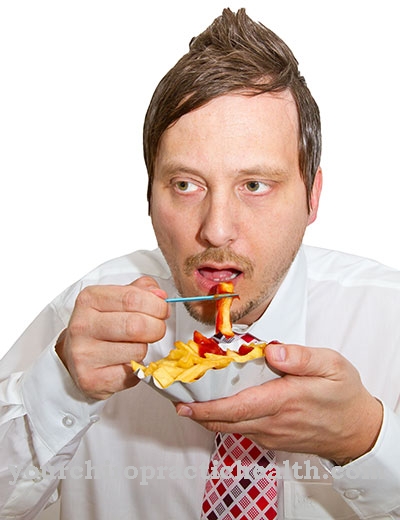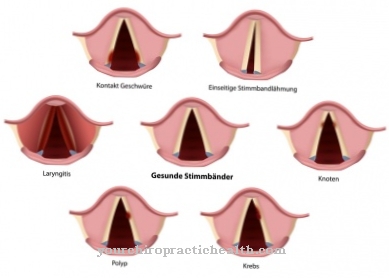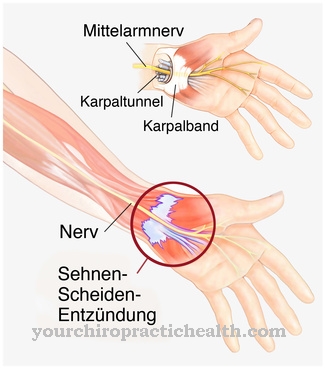At a Cardiac arrest it is always an extremely life-threatening condition for the body. Therefore, first aid measures must be initiated very quickly in order to restore cardiac activity. The reasons for cardiac arrest are very different.
What is cardiac arrest?

© fotohansel - stock.adobe.com
Cardiac arrest is when the heart has stopped beating. As a result, there is no longer any blood circulation, the brain and all other parts of the body, such as organs and limbs, are no longer supplied with blood and thus oxygen.
Cardiac arrest is therefore a very life-threatening condition that can lead to the death of the affected patient within minutes. The heart is controlled by electrical impulses that cause the heart muscles to contract.
As a result, the blood circulation takes place, in which the heart pumps the blood through the body in a certain cycle. If the rhythm of the electrical impulses is disturbed, cardiac arrest can occur. Cardiac arrest is also known as sudden cardiac death in the event of death.
causes
The causes of cardiac arrest can be very diverse. In many cases, arrhythmias are the cause. In doing so, the heart's natural clock frequency is outside the norm. Either the muscles of the heart work in the wrong order or stop working altogether. The result is cardiac arrest.
But other factors can also trigger cardiac arrest. These include medication, shock, accidents that cause suffocation or electric shocks. Stressful situations and unusual physical stress (e.g. excessive sporting activities) can also trigger cardiac arrest. While the cause of the cardiac arrest lies in the lack of oxygen supply in asphyxiating states, a disturbance of the heart rhythm is responsible for all other factors.
In medically necessary cases, cardiac arrest can also be induced artificially. This is often used for special operations on the heart.
Symptoms, ailments & signs
Cardiac arrest is often caused by protracted heart disease. However, cardiac arrest does not necessarily cause symptoms in advance. Possible warning signs that can herald cardiac arrest are shortness of breath and chest pain that can radiate to the left arm or lower jaw. Many sufferers feel an increasing tightness in the chest area.
Often there is also a general feeling of weakness. Shortly before cardiac arrest, dizziness and fainting can occur, which typically subside quickly and then recur. These symptoms are often accompanied by sweats and a strong feeling of discomfort that quickly increases in intensity. The actual cardiac arrest manifests itself in the fact that the person affected suddenly collapses and no longer reacts to speech and pain stimuli.
The affected person then loses consciousness and ultimately dies of cardiac arrest, unless emergency medical treatment is immediately given. The symptoms of cardiac arrest are unspecific and do not affect everyone. Cardiac arrest often occurs without notice, in other cases it is preceded by a phase of chest pain and difficulty breathing. An impending cardiac arrest cannot usually be identified externally.
Diagnosis & course
The diagnosis of cardiac arrest must be made very quickly in order to protect the affected person from death. In most cases, the affected person will suddenly become unconscious. Therefore the patient can no longer express any complaints and the people present have to act quickly and carefully.
If you suddenly lose consciousness, you should always call the emergency services. It should be clearly stated here that this is an extreme emergency in which the patient has lost consciousness and a cardiac arrest is suspected.
Cardiac arrest is usually very easy to determine, even for laypeople: there is no more heartbeat, therefore no pulse can be felt and the patient is no longer breathing. As a result of these factors, the person concerned loses consciousness and can no longer be addressed. After that, first aid measures are very important for the patient's survival.
Complications
Cardiac arrest is itself a complication and, if left untreated, usually leads to death. Only in very rare cases does the cardiac arrest go away on its own. As a rule, the person concerned dies after a few minutes if no first aid measures are initiated. A heart massage must be performed to revive the patient.
In most cases, before cardiac arrest, patients lose consciousness and fall, which can result in serious injury. The diagnosis of cardiac arrest is relatively quick and easy due to the lack of a pulse, so that treatment can begin early. A defibrillator is also used for resuscitation. However, it is never possible to predict in general terms whether or not the patient can be resuscitated after cardiac arrest.
The longer the standstill, the less likely it is to be resuscitated. The internal organs are damaged by the insufficient supply of oxygen. This can lead to consequential damage and serious complications even after the treatment of the cardiac arrest. Life expectancy is severely limited and also depends on the treatment of cardiac arrest.
When should you go to the doctor?
In the event of a cardiac arrest, the emergency services must be called immediately. Until the emergency doctor arrives, first aid measures must be provided. A longer hospital stay is then always indicated. Regular check-ups must then be carried out in order to detect complications at an early stage and ensure a positive healing process. Ideally, the first signs of cardiac arrest should be clarified and treated by a doctor.
Patients who have heart disease or are at increased risk of cardiac arrest for other reasons should see a doctor if they experience difficulty breathing, general weakness, and sudden chest pain. At the latest, when a feeling of tightness occurs, combined with other symptoms such as inner restlessness and palpitations, medical advice is required. The person affected must immediately go to a hospital or seek emergency medical care. In addition to the family doctor, a cardiologist can also be called in. In the case of serious ailments, therapeutic advice is also useful. Cardiac arrest always requires extensive examination and treatment. Otherwise there is an acute danger to life.
Doctors & therapists in your area
Treatment & Therapy
In the event of a cardiac arrest, very rapid treatment is extremely important to ensure the patient's survival. If the heart stands still, the body, the brain and all organs are no longer supplied with blood and oxygen. It is a very life-threatening situation. Correct and targeted action is therefore crucial for the patient's survival.
Since a cardiac arrest is usually very easy to recognize, it is not a problem to take immediate action. After the people present have called the emergency number, first aid measures should therefore be started immediately. This includes a cardiopulmonary resuscitation, which should be carried out until the emergency services arrive. In the event of a cardiac arrest, it is the only way to continue supplying the brain and organs with oxygen and thus prevent them from dying. Without attempts at resuscitation, the patient risks death within a few minutes.
After the paramedics arrive, they will try to restore heart activity. A so-called defibrillator is often used for this. This device sends electric shocks to the heart, which can cause the heart to start beating again.
During all the measures taken, chest compressions and ventilation will continue to be carried out to prevent parts of the body from dying off. When the patient regains consciousness and the heart has resumed its activity, an inpatient stay is prescribed. The patient is closely monitored and the cause of the cardiac arrest is sought. Depending on the reason for the cardiac arrest, further therapy may be necessary to prevent further incidents.
Outlook & forecast
Cardiac arrest is a life-threatening condition and ends in the patient's death if they cannot be helped within a few minutes. Either first aid must be provided on the spot, or the attending physician is nearby and can use a defibrillator to get the stopped heart beating again.
If the cardiac arrest can be reversed, the blood flow gets going again and the patient either wakes up immediately or within the next few minutes and hours. If no help is available, the heart may not start beating again on its own and the patient may die. Depending on the cause of the cardiac arrest and the patient's state of health, it is not unlikely that further cardiac arrests will occur. Each time there is a risk that the heart will not start beating again and the patient will later die.
That is why it is important to be admitted to the hospital with close control and monitoring, and medication must also be administered. This increases a person's long-term chances of survival after cardiac arrest immensely and ensures that they are more likely to get well again. If he has been defibrillated, he will still feel mild to moderate pain for a few hours or days. The intensity depends on the strength of the current that was necessary to reverse the cardiac arrest.
prevention
There is no one hundred percent prevention of cardiac arrest. It is not uncommon for this to affect people who appear absolutely healthy, do a little sport and lead a healthy life. However, there are risk factors such as Obesity, smoking and an unhealthy lifestyle. Frequent stress should also be avoided as it increases the risk of heart disease.
Aftercare
The acute treatment is regularly followed by several days of rehab. Doctors, psychologists, nutritionists and physiotherapists look after those affected. Risk factors for a new cardiac arrest should be excluded as far as possible. The subjects of exercise, nutrition as well as psychological and social perception are discussed. At home, the next step is to apply what you have learned in everyday life.
For this, patients bear a high degree of personal responsibility. Smoking in particular is considered the number one risk factor. In order to make a change in life, exchanging ideas with like-minded people has proven itself. Practical tips can be discussed in small groups. Prevention is therefore of crucial importance for a symptom-free life.
In addition to avoiding triggering factors, drug treatment plays an important role. It is not uncommon for beta blockers, ACE inhibitors and acetylsalicylic acid to extend to the rest of life. This is about making the heart work more efficiently, lowering blood pressure and reducing blood clotting.
The prescription substances are sometimes associated with side effects. Regular follow-up care by the attending physician is therefore advisable. Internists and cardiologists in particular are suitable contacts. You will do a heart and blood exam. The medical history should exclude risk factors.
You can do that yourself
In cardiac arrest, the heart stops beating. The blood circulation collapses and the brain and all other organs are no longer supplied with blood and oxygen. Cardiac arrest is an acute danger to life. The person affected is unconscious and has to rely on those around him to immediately take appropriate rescue measures.
In the event of a cardiac arrest, the emergency doctor must be called immediately. Appropriate first aid measures should be initiated immediately after an emergency call is made. One of the central measures is cardiopulmonary resuscitation, which must not be interrupted until the emergency services arrive. The first thing to do is to check that the airways are clear and not blocked by vomit or foreign bodies. Only then is the patient laid flat on his back and chest compressions in combination with and mouth-to-mouth or mouth-to-nose ventilation started. During resuscitation, the palm of your hand is pressed against your sternum, which puts pressure on the heart. The pressure movement is repeated 30 times, after which an attempt is made to supply air to the patient through the nose or mouth.
The social environment of high-risk patients who have already suffered cardiac arrest or a heart attack should familiarize themselves with the method of cardiopulmonary resuscitation. In the case of cardiac arrest, the survival of the person affected depends on the ability to safely master this measure.



.jpg)
























.jpg)